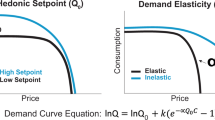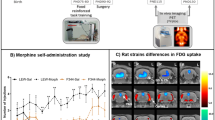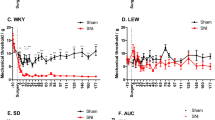Abstract
Lewis rats show increased anxiety-like behaviors and drug consumption compared with Sprague-Dawley rats. Prior work suggests norepinephrine (NE) signaling in the bed nucleus of the stria terminalis (BNST) could have a role in mediating these phenotypes. Here, we investigated NE content and dynamics in the ventral BNST (vBNST) using fast-scan cyclic voltammetry in these two rat strains. We found that NE release evoked by electrical stimulus and its subsequent uptake was dysregulated in the more anxious Lewis rats. Because addiction is a multifaceted disease influenced by both genetic and environmental factors, we hypothesized NE dynamics would vary in these strains after the induction of a physical dependence on morphine. Following naloxone-precipitated morphine withdrawal, NE release and uptake dynamics were not changed in Lewis rats but were significantly altered in Sprague-Dawley rats. The alterations in Sprague-Dawley rats were accompanied by an increase in anxiety-like behavior in those animals as measured with the elevated plus maze. These studies suggest novel mechanisms involved in the development of affective disorders, and highlight the noradrenergic system in the vBNST as a common substrate for the manifestation of pathological anxiety and addiction.
Similar content being viewed by others
Log in or create a free account to read this content
Gain free access to this article, as well as selected content from this journal and more on nature.com
or
References
Amitai N, Liu J, Schulteis G (2006). Discrete cues paired with naloxone-precipitated withdrawal from acute morphine dependence elicit conditioned withdrawal responses. Behav Pharmacol 17: 213–222.
Armstrong JM, Lefevre-Borg F, Scatton B, Cavero I (1982). Urethane inhibits cardiovascular responses mediated by the stimulation of alpha-2 adrenoceptors in the rat. J Pharmacol Exp Ther 223: 524–535.
Cecchi M, Khoshbouei H, Javors M, Morilak DA (2002). Modulatory effects of norepinephrine in the lateral bed nucleus of the stria terminalis on behavioral and neuroendocrine responses to acute stress. Neuroscience 112: 13–21.
Cohen H, Zohar J, Gidron Y, Matar MA, Belkind D, Loewenthal U et al (2006). Blunted HPA axis response to stress influences susceptibility to posttraumatic stress response in rats. Biol Psychiatry 59: 1208–1218.
Delfs JM, Zhu Y, Druhan JP, Aston-Jones G (2000). Noradrenaline in the ventral forebrain is critical for opiate withdrawal-induced aversion. Nature 403: 430–434.
Drolet G (2009) Progress in Neuro-Psychopharmacology and Biological Psychiatry. Elsevier Inc: Amsterdam.
Dumont EC, Williams JT (2004). Noradrenaline triggers GABAA inhibition of bed nucleus of the stria terminalis neurons projecting to the ventral tegmental area. J Neurosci 24: 8198–8204.
Duvarci S, Bauer EP, Pare D (2009). The bed nucleus of the stria terminalis mediates inter-individual variations in anxiety and fear. J Neurosci 29: 10357–10361.
Erb S, Hitchcott PK, Rajabi H, Mueller D, Shaham Y, Stewart J (2000). Alpha-2 adrenergic receptor agonists block stress-induced reinstatement of cocaine seeking. Neuropsychopharmacology 23: 138–150.
Forray MI, Gysling K (2004). Role of noradrenergic projections to the bed nucleus of the stria terminalis in the regulation of the hypothalamic-pituitary-adrenal axis. Brain Res Brain Res Rev 47: 145–160.
Gasser PJ, Orchinik M, Raju I, Lowry CA (2009). Distribution of organic cation transporter 3, a corticosterone-sensitive monoamine transporter, in the rat brain. J Compar Neurol 512: 529–555.
George FR, Goldberg SR (1989). Genetic approaches to the analysis of addiction processes. Trends Pharmacol Sci 10: 78–83.
Heilig M, Egli M (2006). Pharmacological treatment of alcohol dependence: target symptoms and target mechanisms. Pharmacol Ther 111: 855–876.
Herr NR, Park J, McElligott ZA, Belle AM, Carelli RM, Wightman RM (2012). In vivo voltammetry monitoring of electrically evoked extracellular norepinephrine in subregions of the bed nucleus of the stria terminalis. J Neurophysiol 107: 1731–1737.
Hyman SM, Hong KI, Chaplin TM, Dabre Z, Comegys AD, Kimmerling A et al (2009). A stress-coping profile of opioid dependent individuals entering naltrexone treatment: a comparison with healthy controls. Psychol Addict Behav 23: 613–619.
John CE, Budygin EA, Mateo Y, Jones SR (2006). Neurochemical characterization of the release and uptake of dopamine in ventral tegmental area and serotonin in substantia nigra of the mouse. J Neurochem 96: 267–282.
Koob GF (2009). Brain stress systems in the amygdala and addiction. Brain Res 1293: 61–75.
Koob GF, Volkow ND (2010). Neurocircuitry of addiction. Neuropsychopharmacology 35: 217–238.
Leri F, Flores J, Rodaros D, Stewart J (2002). Blockade of stress-induced but not cocaine-induced reinstatement by infusion of noradrenergic antagonists into the bed nucleus of the stria terminalis or the central nucleus of the amygdala. J Neurosci 22: 5713–5718.
McElligott ZA, Klug JR, Nobis WP, Patel S, Grueter BA, Kash TL et al (2010). Distinct forms of Gq-receptor-dependent plasticity of excitatory transmission in the BNST are differentially affected by stress. Proc Natl Acad Sci USA 107: 2271–2276.
McElligott ZA, Winder DG (2008). Alpha1-adrenergic receptor-induced heterosynaptic long-term depression in the bed nucleus of the stria terminalis is disrupted in mouse models of affective disorders. Neuropsychopharmacology 33: 2313–2323.
McElligott ZA, Winder DG (2009). Modulation of glutamatergic synaptic transmission in the bed nucleus of the stria terminalis. Prog Neuropsychopharmacol Biol Psychiatry 33: 1329–1335.
Meloni EG, Gerety LP, Knoll AT, Cohen BM, Carlezon Jr WA (2006). Behavioral and anatomical interactions between dopamine and corticotropin-releasing factor in the rat. J Neurosci 26: 3855–3863.
Montague PR, McClure SM, Baldwin PR, Phillips PE, Budygin EA, Stuber GD et al (2004). Dynamic gain control of dopamine delivery in freely moving animals. J Neurosci 24: 1754–1759.
Nobis WP, Kash TL, Silberman Y, Winder DG (2011). beta-Adrenergic receptors enhance excitatory transmission in the bed nucleus of the stria terminalis through a corticotrophin-releasing factor receptor-dependent and cocaine-regulated mechanism. Biological psychiatry 69: 1083–1090.
Pardon MC, Gould GG, Garcia A, Phillips L, Cook MC, Miller SA et al (2002). Stress reactivity of the brain noradrenergic system in three rat strains differing in their neuroendocrine and behavioral responses to stress: implications for susceptibility to stress-related neuropsychiatric disorders. Neuroscience 115: 229–242.
Park J, Kile BM, Wightman RM (2009). In vivo voltammetric monitoring of norepinephrine release in the rat ventral bed nucleus of the stria terminalis and anteroventral thalamic nucleus. Eur J Neurosci 30: 2121–2133.
Park J, Wheeler RA, Fontillas K, Keithley RB, Carelli RM, Wightman RM (2012). Catecholamines in the bed nucleus of the stria terminalis reciprocally respond to reward and aversion. Biol Psychiatry 71: 327–334.
Picetti R, Caccavo JA, Ho A, Kreek MJ (2012). Dose escalation and dose preference in extended-access heroin self-administration in Lewis and Fischer rats. Psychopharmacology 220: 163–172.
Raskind MA, Dobie DJ, Kanter ED, Petrie EC, Thompson CE, Peskind ER (2000). The alpha1-adrenergic antagonist prazosin ameliorates combat trauma nightmares in veterans with posttraumatic stress disorder: a report of 4 cases. J Clin Psychiatry 61: 129–133.
Sanchez-Cardoso P, Higuera-Matas A, Martin S, del Olmo N, Miguens M, Garcia-Lecumberri C et al (2007). Modulation of the endogenous opioid system after morphine self-administration and during its extinction: a study in Lewis and Fischer 344 rats. Neuropharmacology 52: 931–948.
Schulteis G, Heyser CJ, Koob GF (1999). Differential expression of response-disruptive and somatic indices of opiate withdrawal during the initiation and development of opiate dependence. Behav Pharmacol 10: 235–242.
Simpson TL, Saxon AJ, Meredith CW, Malte CA, McBride B, Ferguson LC et al (2008). A pilot trial of the alpha-1 adrenergic antagonist, Prazosin, for alcohol dependence. Alcohol Clin Exp Res 33: 255–263.
Sinha R (2008). Chronic stress, drug use, and vulnerability to addiction. Ann N Y Acad Sci 1141: 105–130.
Trendelenburg AU, Klebroff W, Hein L, Starke K (2001). A study of presynaptic alpha2-autoreceptors in alpha2A/D-, alpha2B- and alpha2C-adrenoceptor-deficient mice. Naunyn-Schmiedeberg Arch Pharmacol 364: 117–130.
Trescot AM, Datta S, Lee M, Hansen H (2008). Opioid pharmacology. Pain Physician 11 (2 Suppl): S133–S153.
Wang X, Cen X, Lu L (2001). Noradrenaline in the bed nucleus of the stria terminalis is critical for stress-induced reactivation of morphine-conditioned place preference in rats. Eur J Pharmacol 432: 153–161.
Wightman RM, Amatore C, Engstrom RC, Hale PD, Kristensen EW, Kuhr WG et al (1988). Real-time characterization of dopamine overflow and uptake in the rat striatum. Neuroscience 25: 513–523.
Xu F, Gainetdinov RR, Wetsel WC, Jones SR, Bohn LM, Miller GW et al (2000). Mice lacking the norepinephrine transporter are supersensitive to psychostimulants. Nat Neurosci 3: 465–471.
Yorgason JT, Espana RA, Jones SR (2011). Demon voltammetry and analysis software: analysis of cocaine-induced alterations in dopamine signaling using multiple kinetic measures. J Neurosci Methods 202: 158–164.
Acknowledgements
We thank Dr Michael Saddoris for advice on statistical methods, Dr Ryan Vetrano and Dr Fulton Crews for behavioral advice and assistance, and Elyse Dankoski and Dr Thomas Kash for comments on an earlier version of the manuscript. This work was supported by an NIH grant (NS15841) to RMW and the NIMH Psychoactive Drug Screening Program Contract to BLR.
Author information
Authors and Affiliations
Corresponding author
Ethics declarations
Competing interests
BLR has received research support from Dai-Nippon Sumitomo and has been a consultant to Pfizer Pharmaceuticals, SeaChange Pharmaceuticals, Finnegan, Henderson, Faraboug, Garnett and Henderson LLP and Dai-Nippon Sumitomo Pharmaceuticals. BLR also receives payment from the Journal of Clinical Investigation for his duties as Associate Editor of the JCI. The remaining authors declare no conflict of interest.
Additional information
Supplementary Information accompanies the paper on the Neuropsychopharmacology website
Rights and permissions
About this article
Cite this article
McElligott, Z., Fox, M., Walsh, P. et al. Noradrenergic Synaptic Function in the Bed Nucleus of the Stria Terminalis Varies in Animal Models of Anxiety and Addiction. Neuropsychopharmacol 38, 1665–1673 (2013). https://doi.org/10.1038/npp.2013.63
Received:
Revised:
Accepted:
Published:
Issue date:
DOI: https://doi.org/10.1038/npp.2013.63
Keywords
This article is cited by
-
Reciprocal Catecholamine Changes during Opiate Exposure and Withdrawal
Neuropsychopharmacology (2017)
-
Stress and Drug Dependence Differentially Modulate Norepinephrine Signaling in Animals with Varied HPA Axis Function
Neuropsychopharmacology (2015)
-
Antidepressant-like effects of guanfacine and sex-specific differences in effects on c-fos immunoreactivity and paired-pulse ratio in male and female mice
Psychopharmacology (2015)



